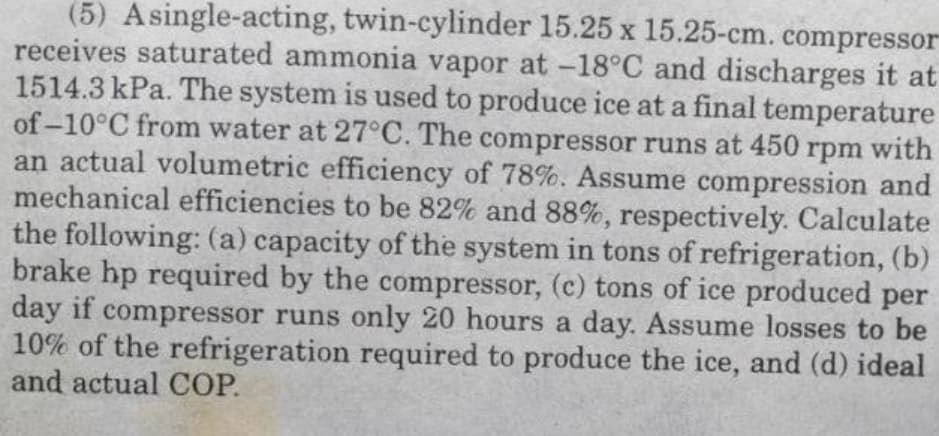(5) Asingle-acting, twin-cylinder 15.25 x 15.25-cm. compresson receives saturated ammonia vapor at -18°C and discharges it at 1514.3 kPa. The system is used to produce ice at a final temperature of-10°C from water at 27°C. The compressor runs at 450 rpm with an actual volumetric efficiency of 78%. Assume compression and mechanical efficiencies to be 82% and 88%, respectively. Calculate the following: (a) capacity of the system in tons of refrigeration, (b) brake hp required by the compressor, (c) tons of ice produced per day if compressor runs only 20 hours a day. Assume losses to be 10% of the refrigeration required to produce the ice, and (d) ideal and actual COP.
(5) Asingle-acting, twin-cylinder 15.25 x 15.25-cm. compresson receives saturated ammonia vapor at -18°C and discharges it at 1514.3 kPa. The system is used to produce ice at a final temperature of-10°C from water at 27°C. The compressor runs at 450 rpm with an actual volumetric efficiency of 78%. Assume compression and mechanical efficiencies to be 82% and 88%, respectively. Calculate the following: (a) capacity of the system in tons of refrigeration, (b) brake hp required by the compressor, (c) tons of ice produced per day if compressor runs only 20 hours a day. Assume losses to be 10% of the refrigeration required to produce the ice, and (d) ideal and actual COP.
Elements Of Electromagnetics
7th Edition
ISBN:9780190698614
Author:Sadiku, Matthew N. O.
Publisher:Sadiku, Matthew N. O.
ChapterMA: Math Assessment
Section: Chapter Questions
Problem 1.1MA
Related questions
Question
Letter C and D only

Transcribed Image Text:(5) Asingle-acting, twin-cylinder 15.25 x 15.25-cm. compressor
receives saturated ammonia vapor at -18°C and discharges it at
1514.3 kPa. The system is used to produce ice at a final temperature
of -10°C from water at 27°C. The compressor runs at 450 rpm with
an actual volumetric efficiency of 78%. Assume compression and
mechanical efficiencies to be 82% and 88%, respectively. Calculate
the following: (a) capacity of the system in tons of refrigeration, (b)
brake hp required by the compressor, (c) tons of ice produced per
day if compressor runs only 20 hours a day. Assume losses to be
10% of the refrigeration required to produce the ice, and (d) ideal
and actual COP.
Expert Solution
This question has been solved!
Explore an expertly crafted, step-by-step solution for a thorough understanding of key concepts.
Step by step
Solved in 2 steps with 3 images

Recommended textbooks for you

Elements Of Electromagnetics
Mechanical Engineering
ISBN:
9780190698614
Author:
Sadiku, Matthew N. O.
Publisher:
Oxford University Press

Mechanics of Materials (10th Edition)
Mechanical Engineering
ISBN:
9780134319650
Author:
Russell C. Hibbeler
Publisher:
PEARSON

Thermodynamics: An Engineering Approach
Mechanical Engineering
ISBN:
9781259822674
Author:
Yunus A. Cengel Dr., Michael A. Boles
Publisher:
McGraw-Hill Education

Elements Of Electromagnetics
Mechanical Engineering
ISBN:
9780190698614
Author:
Sadiku, Matthew N. O.
Publisher:
Oxford University Press

Mechanics of Materials (10th Edition)
Mechanical Engineering
ISBN:
9780134319650
Author:
Russell C. Hibbeler
Publisher:
PEARSON

Thermodynamics: An Engineering Approach
Mechanical Engineering
ISBN:
9781259822674
Author:
Yunus A. Cengel Dr., Michael A. Boles
Publisher:
McGraw-Hill Education

Control Systems Engineering
Mechanical Engineering
ISBN:
9781118170519
Author:
Norman S. Nise
Publisher:
WILEY

Mechanics of Materials (MindTap Course List)
Mechanical Engineering
ISBN:
9781337093347
Author:
Barry J. Goodno, James M. Gere
Publisher:
Cengage Learning

Engineering Mechanics: Statics
Mechanical Engineering
ISBN:
9781118807330
Author:
James L. Meriam, L. G. Kraige, J. N. Bolton
Publisher:
WILEY